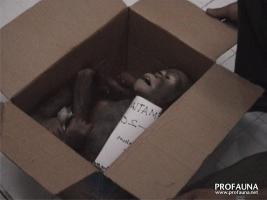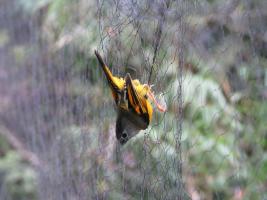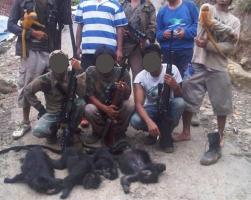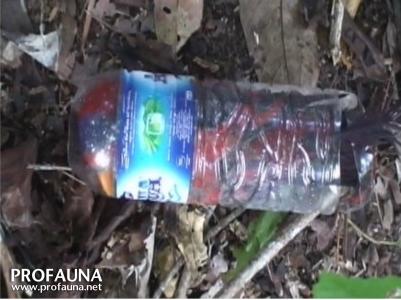Some Facts Behind Wildlife Trade: Ultimate Cruelty
Around 40% of traded wildlife species die during the process, started from distressing capture, meager transportation, tight cages, and insufficient food. To capture a parrot, poachers set up a glue trap in tall trees. The tangled birds will wriggle and finally fall to the ground. to prevent the bird from fleeing, poachers will also tear off the bird's' flight feathers. This is why the birds sold in markets look very docile, because they have lost their ability to fly far.
The poor parrots will be cramped into small bags to be sold to collectors, who later will stuff them into plastic bottles or pipes to be shipped illegally to Java.
 Most of the traded orangutans are babies, and to get them poachers had to kill their mothers because female orangutans will protect their babies with their life. If you see a baby orangutan being sold somewhere, then at least there had been another orangutan died in the hands of the poachers.
Most of the traded orangutans are babies, and to get them poachers had to kill their mothers because female orangutans will protect their babies with their life. If you see a baby orangutan being sold somewhere, then at least there had been another orangutan died in the hands of the poachers.
Slow Loris that are often sold in markets and malls look so cuddly, tame, and cute. They are naturally active at night, but very often they are forced to be active during the day to attract buyers. 70% of the traded Slow Lorises have had their teeth removed, to prevent them from biting. The teeth are pulled out with pliers, while the poor creature were spun around until the teeth come off, along with lots of blood. During the process, the Slow Lorises will helplessly squeak in vain before the heinous dealers
Primates (monkeys and apes) are sold not only alive to be kept as pets, but also for their meat. Using a hidden cam, PROFAUNA documented the process of monkey slaughter.
We were shocked because it turned out that the monkeys were burnt alive! They kept on struggling until they die. After that, their bodies will be cut to small pieces for soup or satay.
 To capture birds, poachers usually set up a snare as wide as 25 meters in forests or fields. They can have up to 10 snares at a time, put in between trees and bushes. Using this method, all birds big and small, rare and common, will be trapped.
To capture birds, poachers usually set up a snare as wide as 25 meters in forests or fields. They can have up to 10 snares at a time, put in between trees and bushes. Using this method, all birds big and small, rare and common, will be trapped.
The trapped birds will struggle to get loose from the snare. But, the harder they struggle, the tighter the snare gets. The birds will eventually be exhausted , and 30% of the trapped birds die before they even get to the market. The surviving birds will later be packed in small paper bags or bamboo canes to be transported and sold in bird markets.
 To catch bigger animals like primates or big cats, poachers sometimes make use of hounds. One poacher usually takes 3-10 dogs to the hunting spot. The dogs will bark on and hunt the target animals. The target animals will be stress, get panicked, terrified, and lost their energy for running away from the hounds. This makes them an easy prey. Many of the animals have suffered from stress during the capture, and the stress level will escalate when they are being displayed in the markets.
To catch bigger animals like primates or big cats, poachers sometimes make use of hounds. One poacher usually takes 3-10 dogs to the hunting spot. The dogs will bark on and hunt the target animals. The target animals will be stress, get panicked, terrified, and lost their energy for running away from the hounds. This makes them an easy prey. Many of the animals have suffered from stress during the capture, and the stress level will escalate when they are being displayed in the markets.
"By not buying wildlife, we already help in breaking the chain of illegal wildlife trade. Real animal lovers will let wildlife live in the wild."

